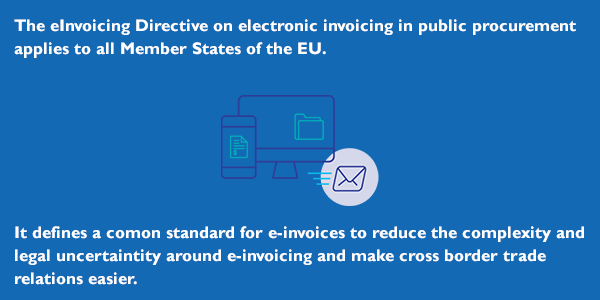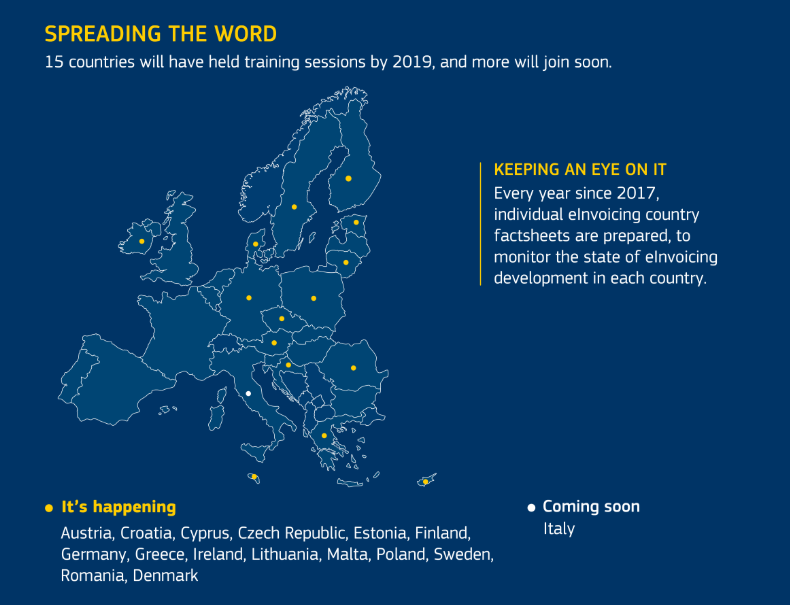What are they, and what impact is there on businesses outside of the EU?
Following the EU Commission’s announcement on 18 April 2019, businesses may or may not be aware the e-invoicing Directive came into force. The rationale for stating ‘may not’ is because, it’s not necessarily considered news of major significance, especially since most businesses are likely to have had an invoicing system in place for some time. So therefore, the aim of this post is to provide an outline of what consideration businesses will need to adhere to and indeed, in some instances, to highlight the fact that some companies may have been in breach of the EU VAT Directive for many years.
What is the purpose of the e-Invoicing Directive (Directive 2014/55/EU)?
In 2014, EU countries and the European Commission introduced a standard for e-invoicing. Prior to this date, various e-invoice formats were used across the EU. Processing these required additional time and resources and lead to high costs for businesses and public sector entities.

As of 18 April 2019 - the deadline for transposing the Directive into national laws of EU countries - public authorities engaging in public procurement in the EU should comply with the European standard on e-invoicing and be able to receive and process electronic invoices accordingly, resulting in a seamless flow across the EU.
The new standard will help to ensure the timely and automatic processing of companies' e-invoices and payments, make it easier for companies to manage their contracts in any Member State and raise the attractiveness of public procurement businesses.
Who is affected by the new eInvoicing Directive?
The Directive applies to all EU public sector entities, such as national or local governments and educational institutions. It’s important to note that the Directive does not require the use of e-invoicing. Public entities can still accept paper invoices, though it should also be noted that many countries are steadily moving away from them. The big change is that under the new Directive, if they receive an e-invoice that meets the new standards they are required to accept and process it.
This means any suppliers that do business with public entities in the EU should ensure their e-invoices meet the standards set forth by the Directive.

Prior to the e-invoicing Directive- Invoicing and fraud
Invoices arrive into a company in various ways - it could be paper, a PDF scan, post, email, web portal and so on. Therefore, there are multiple ways for criminals to corrupt an invoice or part of the process. For example, embedding a virus into an attachment, sending duplicates, notification of false account details by email. The more complicated the process, the more risk.
The consideration will then need to be how is this fraud dealt with? How is any substantial amount recovered? And then ultimately, the risk to a company’s brand.
|
2018 saw 3,280 invoice and bank mandate scam cases involving businesses. Each loss per case averaged at a staggering £28,000. Thankfully, around £29.6 million of the money lost to invoice fraud was recovered. Source: https://smallbusiness.co.uk/supplier-fraud-real-risk-protect-business-2543085/ |
The Role of the VAT Directive - Authenticity of Origin and Integrity of Content
The need for security in electronic invoices – including preventing corruption and proving the identity of the invoice generator - has been clear for years. In fact, the EU VAT Directive established provisions for this when it came out way back in 2006.
Per the VAT Directive (article 233), each taxable person (i.e. both supplier and buyer) is obliged to ensure "authenticity of origin" (i.e., the identity of the invoice issuer) and "integrity of content" (i.e., the content of the invoice has not been changed from the moment of issuance). One of the core methods the VAT Directive suggests is to use advanced electronic signatures.
The new e-Invoicing Directive leverages these provisions established in the VAT Directive, including the ability to use advanced electronic signatures to guarantee invoice authenticity and integrity, and specifies all senders of e-invoices, not just VAT entities, must be able to guarantee this.
What are the implications?
Consider this:
- Only invoices in the specific structured format will be recognised as valid e-invoices within the EU.
- From 18 April 2019, authorities in each EU Member State must be able to receive and process e-invoices that meet the standards specified by the Directive. Regional and local authorities may obtain an exception for an additional year.
What about companies outside of the EU?
Per the Directive, public sector entities based within the EU will need to accept any e-invoices that meet the standards specified in the Directive.
This means any suppliers – no matter where they are based – doing business with public entities in the EU should ensure their e-invoices meet the standards set forth by the Directive. If you are a global company that sends invoices to various countries within the EU, then you will need to fully understand the requirements to be compliant. We focused on the authenticity and integrity requirements above, but you can review the full Directive here. CEF Digital also has some great materials on how to comply.
As for companies that are within the EU and have not considered amending their existing e-invoicing solution in order to be compliant, what are you waiting for?
How GlobalSign Can Help
GlobalSign’s popular Document Signing Service (DSS) is a cloud-based, highly scalable, API driven offering that seamlessly integrates with document workflow solutions and enables secure and compliant document signing.
DSS makes it easy to build advanced electronic signatures directly into existing e-invoice generation workflows without requiring significant development time, PKI expertise, hardware investment or ongoing management.
To learn more about how GlobalSign’s Digital Signing Service supports the new EU Directive visit https://www.globalsign.com/en/lp/e-invoicing-directive-dss/.
For more general background about our Digital Signing Service, visit https://www.globalsign.com/en/digital-signatures/cloud/.







